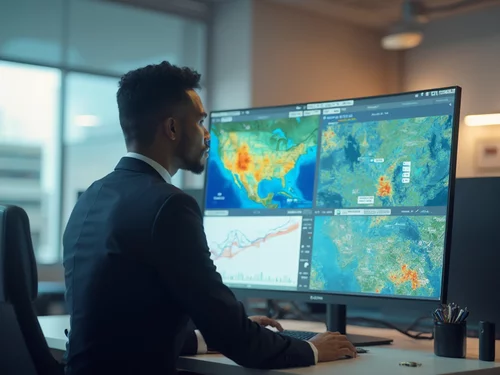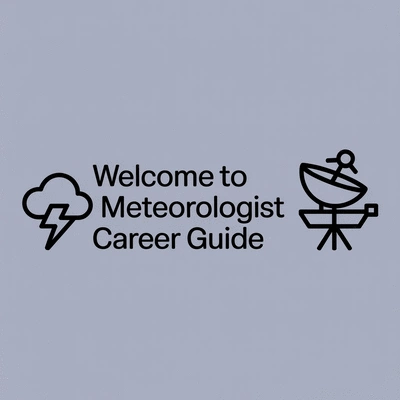Have you ever looked up at the sky and wondered how meteorologists predict the weather? The world of weather forecasting is a fascinating blend of science, technology, and real-world application, all aimed at helping us make informed decisions. Understanding this intricate field can empower you to prepare for the unpredictable nature of our atmosphere.
What You Will Learn
- Meteorologists utilize advanced data analysis techniques to enhance the accuracy of weather predictions.
- Key instruments like satellite imagery, weather radars, and anemometers play a critical role in gathering weather data.
- Weather forecasts significantly impact various sectors, including agriculture, emergency services, and public health.
- Understanding climate variability is essential for predicting long-term weather patterns and preparing for extreme weather events.
- Engaging with citizen science initiatives allows individuals to contribute valuable data for local weather monitoring.
Data Analysis and Key Instruments in Meteorology
Meteorologists leverage a combination of data sources and specialized instruments to create accurate weather forecasts. The visual below highlights these crucial elements.
Data Sources for Forecasting
- •Satellite Imagery
- •Weather Radars
- •Weather Balloons
- •Ground Stations
Key Meteorological Instruments
- •Barometers (Atmospheric Pressure)
- •Anemometers (Wind Speed/Direction)
- •Hygrometers (Humidity Levels)
- •Rain Gauges (Precipitation Amounts)
Impact of Data Analysis
- •Enhanced Accuracy
- •Faster Response Times
- •Broader Insights
Key Areas of Weather Impact
- •Agriculture
- •Emergency Services
- •Transportation
- •Public Health
Understanding the Role of Meteorologists in Weather Forecasting
As a passionate meteorologist, I often find myself diving deep into the intricate world of weather forecasting. Understanding the role of meteorologists goes beyond just predicting whether it will rain or shine; it involves a complex interplay of data analysis, technology, and real-world application. Meteorologists play a crucial role in translating vast amounts of data into understandable forecasts that inform daily life.
Through the analysis of historical weather patterns and current atmospheric conditions, we can make predictions that help individuals and communities prepare for various weather scenarios. This is not just about numbers and charts; it’s about making informed decisions that impact everything from agriculture to emergency responses!
How Meteorologists Leverage Data Analysis for Accurate Predictions
Data analysis is at the heart of meteorology. By leveraging advanced analytical techniques and tools, meteorologists are able to enhance the accuracy of their forecasts. We rely on a variety of data sources to make these predictions, including:
- Satellite imagery: Provides real-time visual information about cloud cover and storm systems.
- Weather radars: Help track precipitation and storm movement.
- Weather balloons: Gather data on temperature, humidity, and pressure at various altitudes.
- Ground stations: Offer localized weather measurements, such as temperature and wind speed.
By combining these data streams, we can create comprehensive models that give us insights into upcoming weather patterns. For instance, I often analyze how certain atmospheric conditions correlate with storm developments, allowing for more accurate predictions.
The Importance of Weather Forecasting in Daily Life
Weather forecasting is not just a routine; it’s a vital service that affects our daily decisions. From choosing an outfit to planning outdoor activities, the weather impacts our lives in numerous ways. Understanding this importance can lead to better preparation and safety. Here are a few areas where weather forecasting plays a crucial role:
- Agriculture: Farmers depend on accurate forecasts to plan planting and harvesting.
- Emergency services: Accurate predictions help authorities prepare for natural disasters.
- Transportation: Airlines and shipping companies rely on weather data for safe operations.
- Public health: Forecasts can inform communities about potential weather-related health risks.
As we discuss the various impacts of weather forecasting, it's clear that being informed can empower individuals to make smarter choices and stay safe!
Key Meteorological Instruments Used in Forecasting
The tools we use as meteorologists are essential for gathering and interpreting data. Each instrument has its unique purpose, contributing to the overall accuracy of our forecasts. Here are some key instruments frequently used in meteorology:
- Barometers: Measure atmospheric pressure to predict weather changes.
- Anemometers: Assess wind speed and direction.
- Hygrometers: Gauge humidity levels in the atmosphere.
- Rain gauges: Collect and measure precipitation amounts.
Using these instruments in conjunction allows us to build a clearer picture of what’s happening in our atmosphere. Each device plays a vital role in ensuring that the forecasts we provide are as accurate and reliable as possible.
Frequently Asked Questions About Weather Forecasting
- Q: How do meteorologists predict the weather?
- A: Meteorologists predict weather by analyzing vast amounts of data from sources like satellite imagery, weather radars, weather balloons, and ground stations. They use advanced analytical techniques and models to interpret this data and forecast future weather patterns.
- Q: What are the main instruments used in meteorology?
- A: Key meteorological instruments include barometers (for atmospheric pressure), anemometers (for wind speed and direction), hygrometers (for humidity levels), and rain gauges (for precipitation amounts).
- Q: How does weather forecasting impact daily life and various sectors?
- A: Weather forecasting is crucial for daily decisions and significantly impacts sectors like agriculture (planning planting/harvesting), emergency services (preparing for disasters), transportation (safe operations), and public health (addressing weather-related risks).
- Q: Why is understanding climate variability important for weather forecasting?
- A: Understanding climate variability is essential because it helps meteorologists predict long-term weather patterns and prepare for extreme weather events. Variations in climate parameters over time can lead to changes in precipitation, temperature extremes, and storm frequency/intensity.
- Q: How can individuals contribute to weather monitoring?
- A: Individuals can engage in citizen science initiatives, such as joining weather networks (e.g., CoCoRaHS) to report local precipitation, using weather apps that allow data submissions, or attending local weather workshops.
Exploring Key Weather Forecasting Techniques
In my experience, mastering various weather forecasting techniques is crucial for any aspiring meteorologist. The diversity of methods available opens pathways to understanding weather from multiple perspectives, which is invaluable for accuracy.
Interactive Poll: Your Thoughts on Weather Forecasting!
How important do you think accurate weather forecasting is for your daily life? We'd love to hear your opinion!
Summarizing the Impact of Data Analysis in Weather Science
Data analysis plays a crucial role in the field of meteorology, helping us make sense of the chaotic nature of weather. By integrating various techniques and technologies, meteorologists can enhance the accuracy of their forecasts significantly. From satellite imagery to machine learning algorithms, the tools at our disposal allow us to analyze patterns, trends, and anomalies in weather data.
Some key takeaways on the integration of these techniques include:
- Enhanced Accuracy: Utilizing a combination of data sources leads to more reliable forecasts.
- Faster Response Times: Advanced technologies help meteorologists process data quickly, allowing them to respond to changing weather conditions.
- Broader Insights: Diverse analytical methods provide a comprehensive view of weather phenomena, improving our understanding of climate variability.
As we continue to push the boundaries of weather science, we gain valuable insights that not only improve daily forecasts but also help us prepare for extreme weather events.
The Ongoing Evolution of Meteorological Practices and Forecasting
As a dedicated meteorologist, I've witnessed firsthand how rapidly our field evolves. New advancements in technology and data analysis continually reshape the practices of forecasting. For instance, the introduction of machine learning has revolutionized how we interpret vast datasets, enabling us to recognize patterns that were once hidden from view.
This ongoing evolution also brings about new methodologies, such as ensemble forecasting, which combines multiple models to provide a range of possible outcomes. Here are some aspects to consider in this evolution:
- Interdisciplinary Collaboration: Meteorology is increasingly collaborating with fields such as computer science and environmental science.
- Real-Time Data Utilization: The ability to access and analyze data in real-time is changing the way forecasts are generated.
- Focus on Climate Change: As climate variability becomes more pronounced, our forecasting practices adapt to include longer-term trends and impacts. For example, recent reports, such as the NOAA's monthly report, highlight the global temperature anomalies and their implications, underscoring the dynamic nature of our climate.
As we embrace these changes, it’s essential for aspiring meteorologists to remain adaptable and open to learning, as the landscape of weather forecasting will continue to shift.
Understanding Climate Variability and Its Effects on Weather Patterns
Climate variability refers to the variations in climate parameters over time, and it significantly influences weather patterns. Understanding this concept is vital for anyone looking to delve deeper into meteorology. As the founder of the Meteorologist Career Guide, I emphasize the importance of grasping these concepts for aspiring meteorologists.
Some fundamental effects of climate variability include:
- Changes in Precipitation Patterns: Variability can lead to altered rainfall patterns, impacting agriculture and water resources.
- Temperature Extremes: Shifts in climate can result in more frequent heatwaves or cold snaps, affecting ecosystems and human health. The Berkeley Earth Global Temperature Report for 2024 offers further insights into these trends, demonstrating the ongoing impact of climate shifts.
- Storm Frequency and Intensity: Understanding the connections between climate variability and storm patterns aids in better forecasting. Research, such as that published in Nature, often delves into the intricate relationship between climate change and extreme weather events.
By examining these impacts, we can better predict and prepare for the weather events that affect our communities. Staying informed about climate variability empowers us to make educated decisions regarding our environment and safety.
Engaging with Weather Science: What You Can Do
As someone passionate about meteorology, I believe that everyone can engage with the science of weather in meaningful ways. Whether you’re a student aspiring to become a meteorologist or simply curious about how weather works, there are plenty of opportunities for you to get involved.
How to Interpret Weather Forecasts and Understand Probabilities
Interpreting weather forecasts can be tricky, especially when it comes to understanding probabilities. Here are some tips on how to better interpret what you see:
- Pay Attention to Percentages: A 60% chance of rain means that, in similar past conditions, it rained 60% of the time.
- Look for Trends: Understanding trends over several days can provide insight into how conditions may change.
- Check Multiple Sources: Different weather services may provide varying forecasts; comparing them can give a clearer picture.
By grasping these concepts, you’ll become more adept at making sense of the forecasts impacting your daily life!
Resources for Learning More About Meteorology and Weather Data
For those eager to dive deeper into meteorology, a wealth of resources is available. Here are some recommendations:
- Books: Explore foundational texts on meteorology and atmospheric sciences to build your knowledge.
- Online Courses: Platforms like Coursera and edX offer courses on weather science tailored for various skill levels.
- Webinars and Workshops: Participate in events hosted by meteorological societies for hands-on learning opportunities.
These resources will not only enhance your understanding but also help you keep up with the latest advancements in the field.
Participating in Citizen Science for Local Weather Monitoring
Engaging in citizen science is a fantastic way to contribute to weather data collection and analysis. By participating, you can play a role in gathering essential data to help meteorologists make accurate forecasts. Here are ways to get involved:
- Join Weather Networks: Organizations like the CoCoRaHS (Community Collaborative Rain, Hail and Snow Network) invite volunteers to report local precipitation.
- Use Weather Apps: Some apps allow users to submit data and observations, contributing to a larger dataset.
- Attend Local Weather Workshops: These workshops often include training on how to measure and report weather events.
Your contributions can have a significant impact, enhancing the richness of data available for forecasting and understanding weather patterns.
Recap of Key Points
Here is a quick recap of the important points discussed in the article:
- Meteorologists analyze historical weather patterns and current atmospheric conditions to make informed predictions.
- Key data sources for accurate weather forecasting include satellite imagery, weather radars, weather balloons, and ground stations.
- Weather forecasting has significant impacts on agriculture, emergency services, transportation, and public health.
- Essential meteorological instruments include barometers, anemometers, hygrometers, and rain gauges, each contributing to accurate forecasts.
- Data analysis enhances the accuracy of forecasts and improves response times to changing weather conditions.
- Engaging in citizen science and utilizing resources like online courses can help individuals further their understanding of meteorology.









